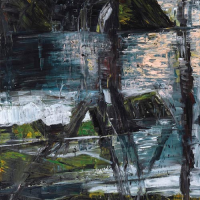62. EUAN MACLEOD

Born in New Zealand and Australian by adoption, Euan Macleod has made our national iconography of the figure in the landscape his own intensely personal domain. For more than forty years he has built a vision in paint that is instantly recognisable and compelling to all who see it. He has won our most significant awards with works of real power and physical presence, and it is telling perhaps that his paintings have fitted the Archibald, Sulman and the Blake Prizes with equal measure and purpose - there is a universality about his style and imagery that defies a narrow description. Macleod was raised and educated in the South Island of New Zealand, a place with its own rugged and distinctive landscape, before moving to Australia where he has travelled widely, working directly in the landscape to understand it at the most elemental level.
In almost every picture he makes, Macleod includes the human figure, but in ways that go far beyond the mere artful placement of a person in a given time and place. At times his figures stride across the mountains like Gulliver, at others they are ghosts barely visible against the scarified rocks and boulders of some desolate land. They will stand motionless in a sunken boat, or sit beneath the waves of a South Island Fiord. A giant figure relaxes in the rock pool of a South Island bay, his arms outstretched across the rocky headlands. Scale and perspective are meaningless in these mind-scapes, places where no man-made structures jostle for our attention. Macleods paintings have a compelling unity - the crusty painted surfaces are carved of the land itself, the colour dry and grainy. There are echoes at times of Albert Tuckers (1914-1999) gnarled miners and explorers, but without the colourful birds which dog their way. Elements too of Sidney Nolan (1917-1992), especially in the Gallipoli works, but with a more direct and personal understanding of the human element. Where Nolan saw Gallipoli in terms of the Homeric myths, Macleod allows modern tourists to wander past the unearthed skeletons of Anzacs and Turks, the nameless and numberless of a century ago.
Euan Macleod slips seamlessly from the landscape of his homeland to that of Australia, relishing the distinctive features which mark each place, so near yet so very different in character. He explores the ice and snow of his own South Island, the brilliant green of its cleared grazing lands and the rugged coastline where land and sea meet in a give and take of sublime drama. Striding Figure across Seascapes sees a giant attenuated figure, wraithlike and translucent, stepping from land to ocean, in and of his own place. The scale is ambiguous and the giant figure reaches from the top corner to the bottom edge of the canvas, stepping out beyond the confines of the painted surface. Lyrical landscape and mystical man meet in an image of authority and confidence. It is not surprising that Macleod has won the Blake Prize for Religious Art, for there is an ever present spiritual dimension to his work. Often we see the artist himself, working alone in the landscape, trying to make sense of his place both in his immediate surroundings and the wider world. It could be any of us, vainly trying to find our way through life, our own place in the universal landscape of human existence.
Gavin Fry